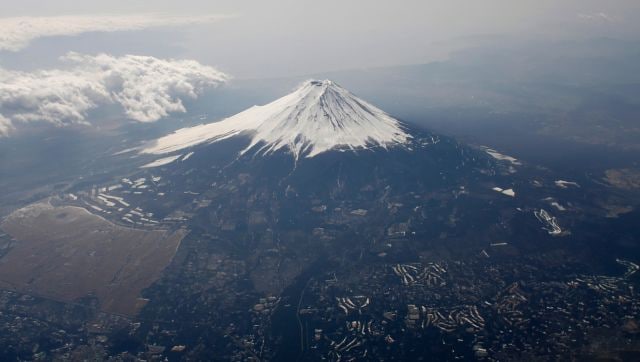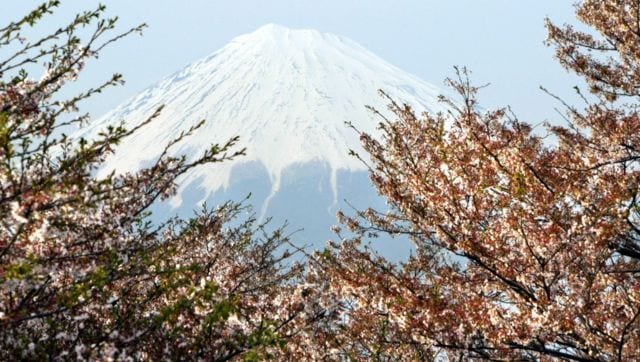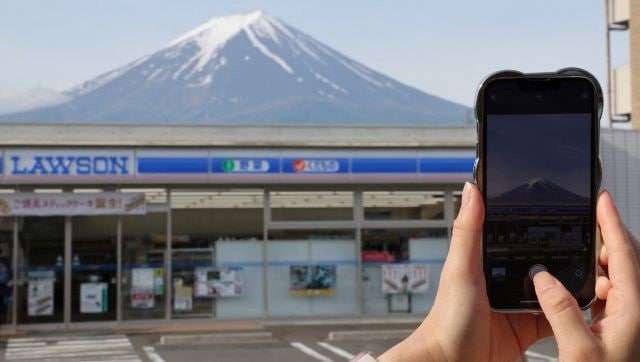Japan’s tallest peak, Mount Fuji, has yet to see any snowfall this year. This marks an unprecedented delay since records started 130 years ago. Typically, the first dusting arrives by early October, indicating the end of the summer climbing season and the beginning of winter
)
November is almost here, but snow has yet to appear on Japan’s famous Mount Fuji.
This is an unprecedented delay since records began 130 years ago, according to the country’s weather agency.
Normally, Mount Fuji’s peak sees its first dusting by early October, signalling the onset of winter following the summer climbing season, which this year ended on September 10.
However, as of Tuesday, no snow has appeared on Japan’s tallest peak due to ongoing unseasonably warm weather, Yutaka Katsuta, a forecaster at the Kofu Local Meteorological Office, said.
Since 1894, Kofu’s meteorological office has usually recorded the season’s first snowfall on Mount Fuji, but this year, rising temperatures and rainfall have kept it snow-free.
Shinichi Yanagi, a meteorological officer at the Kofu office, told CNN, “High temperatures in Japan have persisted since summer, and combined with rain, there has been no snowfall.”
Record-breaking heat and climate shift
This summer was Japan’s hottest on record, with average temperatures from June to August rising 1.76°C (3.1°F) above the usual level.

In September, temperatures continued to exceed expectations, as a northerly shift in the subtropical jet stream allowed warmer air from the south to sweep over Japan. The intense summer heat extended well into October, with over 74 cities experiencing temperatures above 30°C during the first week.
According to Climate Central, a research non-profit, this unusual October heat in Japan was made three times more likely by the climate crisis.
Yutaka Katsuta, a meteorologist, said that climate change could be partly responsible for delaying the formation of snowcaps on mountains.
“Temperatures were high this summer, and these high temperatures continued into September, deterring cold air” which brings snow, he told AFP.
El Nino and global warming
This year’s intense heat was driven by the natural El Nino climate pattern and intensified by human activities, particularly fossil fuel consumption, which is the primary cause of the climate crisis, CNN reported.
Scientists have long cautioned that limiting global warming to 1.5°C above pre-industrial levels is critical to avoid severe climate impacts.
A recent study in January revealed that climate change has diminished snowpacks across much of the Northern Hemisphere over the past four decades.
The delayed snowfall on Mount Fuji may be a sign of more frequent warmer winters, impacting snow levels, tourism, local economies, food and water supplies, and even allergies.

Covering Japan’s Yamanashi and Shizuoka prefectures, Mount Fuji is a 3,776-meter UNESCO World Heritage site and a national icon. Typically, it remains snow-capped much of the year, though the climbing season opens in July, drawing millions eager to hike to the summit or see the sunrise from its famous slopes.
In July, Japanese authorities introduced a new tourism tax and regulations to manage visitor numbers. Climbers now pay a 2,000-yen (£12.40) fee per person, with a maximum daily limit of 4,000 climbers.
Overtourism – another concern?
Mount Fuji, which remains snow-capped for most of the year, has a hiking season from July to September, attracting over 220,000 tourists.
Many climbers climb through the night to witness the sunrise, with some attempting to reach the 3,776-meter (12,388-foot) summit without breaks, leading to injuries and health issues.
This summer, record tourist numbers flocked to Japan, making global headlines and causing some local resistance as communities dealt with crowd-related challenges.
To tackle this, Japanese authorities introduced a climber entry fee and capped daily visitor numbers to tackle overtourism, leading to a slight drop in the number of climbers on Mount Fuji.
Known for its perfect symmetry, Mount Fuji has inspired countless artworks, including Hokusai’s iconic “Great Wave”. Its last eruption occurred around 300 years ago.
When Japan blocked Mt Fuji’s view
To manage unruly tourist behaviour, town officials took measures to deter disruptive visitors. Locals reported issues with tourists jaywalking and littering in their streets.
In March and April, Japan welcomed a record three million tourists. “It’s regrettable we have to do this because some tourists can’t respect the rules,” a town official told AFP in April.
Japan’s tallest peak offers several photography spots in the resort town of Fujikawaguchiko. One particularly popular viewpoint captures the stunning volcano framed by a Lawson convenience store, a common sight across Japan.

The plan gained attention last month as officials, frustrated by the ongoing influx of mainly foreign visitors who were littering, trespassing, and disregarding traffic regulations, announced their decision.
While local officials and residents appreciate the tourism, they have complaints over visitors who consistently cross streets unlawfully, ignore traffic signals, park illegally, and smoke in prohibited areas, AFP reported. This initiative also aimed to protect a nearby dental clinic, where tourists have parked without permission and even climbed onto the roof for photographs.
In Kyoto, locals have complained about tourists harassing the city’s famous geishas. This summer, hikers on Mount Fuji’s most popular route were charged a fee of 2,000 yen (£13), with daily entries capped at 4,000 to ease congestion.
Rising to 12,388 feet, Mount Fuji is a sacred symbol of Japan, surrounded by numerous temples and shrines. Located about 100 km (62 miles) southwest of Tokyo, the mountain can be seen from the capital on clear days. The United Nations Educational, Scientific and Cultural Organization (UNESCO) recognises 25 sites of cultural significance within the Mount Fuji area.
Many other destinations are also facing the challenges of overtourism. In April, Venice implemented entry fees for day-trippers to manage visitor numbers, while tens of thousands in the Canary Islands called for a halt on the influx of tourists.


